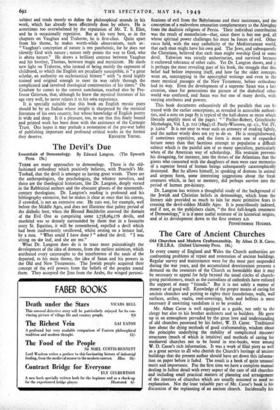The Devil's Due
THERE are many approaches to demonology. There is the old- fashioned orthodoxy which positively believes, with Peacock's Mr. Toobad, that the devil is amongst us having great wrath. There are the anthropologists, the psychologists, the whimsy novelists, and there are the theological historians, like Dr. Langton, deeply versed in the Rabbinical authors and the obscurer glosses of the nineteenth- century theologians. Dr. Langton's reading is profound and his bibliography extensive, but he makes it clear at once that his canvas, if crowded, is not an extensive one. He cuts out, for example, well before the Middle Ages, and does not illustrate that palmy period of the diabolic host, when the Blessed Reichhelm assessed the domain of the Evil One as comprising some 1,758,064,176 devils, and mankind was so densely surrounded by them that in a favourite story St. Equitius, it will be remembered, expelled a devil which had been inadvertently swallowed, whilst resting on a lettuce leaf, by a nun. "What could I have done ? " asked the devil. "I was sitting on the leaf, and she ate me."
What Dr. Langton does do is to trace most painstakingly the development of the idea of demons, from the earliest animism, which attributed every catastrophe to the interference of the souls of the departed, to his main theme, the idea of Satan and his powers in the Old and New Testaments. The Jewish people acquired their concept of the evil powers from the beliefs of the peoples round them. They accepted the Jinn from the Arabs, the winged personi- fications of evil from the Babylonians and their successors, and the conception of a malevolent emanation complementary to the Almighty from the dualistic religions of Persia. Their individual contribution was the result of monotheism—that, since there is but one god, all whose spiritual power challenges his must be forces of evil. Other races held, with the easy catholicity of the Mediterranean world, that each man might have his own god. The Jews, and subsequently the Christians, believed that each man might worship God or some devil. Yahwism was strictly authoritarian, and survived because it eschewed tolerance of other cults. Yet Dr. Langton shows, and it is perhaps the most revealing part of his book, the struggle that this belief had before imposing itself, and how far the older concepts went on, outcropping in the apocryphal writings and even in the more mystical passages of the New Testament, before orthodoxy had its way. Even the development of a supreme Satan was a late creation, since for generations the picture of the diabolical other world was confused, and Satan was but one of many devils, with varying attributes and powers.
This book documents exhaustively all the parallels that can b!. traced with the earlier conceptions, as revealed in accessible authori- ties, and a note on page 85 is typical of the half-dozen or more which liberally amplify most of the pages : " " Preller-Robert, Griechische Mythologic, Vol. I, p. 112 (1894); cf. Pauly-Wissowa, op. cit., Vol. IV, p. 2,010." It is not easy to wear such an armoury of reading lightly, and the author wisely does not try to do so. He is straightforward, if sometimes repetitive, and the form is more one of expanded lecture notes than that facetious attempt to popularise a difficult subject which is the painful aim of so many specialists, particularly when of the American way of scholarship.. His restraint prevents his divagating, for instance' into the theses of the Atlantians that the giants who consorted with the daughters of men were race memories of a superior breed of human beings subsequently catastrophically destroyed. But he allows himself, in speaking of demons in animal and serpent form, some interesting suggestions about the -freak creatures which, in fact or memory, did perhaps survive into the period of human pre-history.
Dr. Langton has written a thoughtful study of the background of the Jewish and Christian beliefs in demonology, which from the literary side provided so much to join far more primitive fears in creating the devil-ridden Middle Ages. It is punctiliously indexed, and if not, as the publishers claim, "the first full-length treatment of Demonology," it is a most useful estimate of its historical origins, and of its development down to the first century A.D.
PENNETHORNE HUGHES.










































 Previous page
Previous page